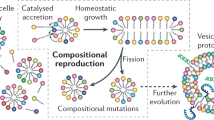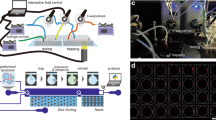Abstract
Although phospholipid bilayers are ubiquitous in modern cells, their impermeability, lack of dynamic properties, and synthetic complexity are difficult to reconcile with plausible pathways of proto-metabolism, growth and division. Here, we present an alternative membrane-free model, which demonstrates that low-molecular-weight mononucleotides and simple cationic peptides spontaneously accumulate in water into microdroplets that are stable to changes in temperature and salt concentration, undergo pH-induced cycles of growth and decay, and promote α-helical peptide secondary structure. Moreover, the microdroplets selectively sequester porphyrins, inorganic nanoparticles and enzymes to generate supramolecular stacked arrays of light-harvesting molecules, nanoparticle-mediated oxidase activity, and enhanced rates of glucose phosphorylation, respectively. Taken together, our results suggest that peptide–nucleotide microdroplets can be considered as a new type of protocell model that could be used to develop novel bioreactors, primitive artificial cells and plausible pathways to prebiotic organization before the emergence of lipid-based compartmentalization on the early Earth.
This is a preview of subscription content, access via your institution
Access options
Subscribe to this journal
Receive 12 print issues and online access
$259.00 per year
only $21.58 per issue
Buy this article
- Purchase on Springer Link
- Instant access to full article PDF
Prices may be subject to local taxes which are calculated during checkout



Similar content being viewed by others
References
Rasmussen, S. et al. (eds) Protocells: Bridging Nonliving and Living Matter (MIT Press, 2009).
Luisi, P. L. The Emergence of Life (Cambridge Univ. Press, 2006).
Hargreaves, W. R. & Deamer, D. W. Liposomes from ionic, single-chain amphiphiles. Biochemistry 17, 3759–3768 (1978).
Szostak, J. W., Bartel, D. P. & Luisi, P. L. Synthesizing life. Nature 409, 387–390 (2001).
Meierhenrich, U. J., Filippi, J. J., Meinert, C., Vierling, P. & Dworkin, J. P. On the origin of primitive cells: from nutrient intake to elongation of encapsulated nucleotides. Angew. Chem. Int. Ed. 49, 3738–3750 (2010).
Deamer, D. W. & Pashley, R. M. Amphiphilic components of the Murchison carbonaceous chondrite: surface properties and membrane formation. Orig. Life Evol. Biosphere 19, 21–38 (1989).
McCollom, T. M., Ritter, G. & Simoneit, B. R. T. Lipid synthesis under hydrothermal conditions by Fischer–Tropsch-type reactions. Orig. Life Evol. Biosphere 29, 153–166 (1999).
Mansy, S. S. et al. Template-directed synthesis of a genetic polymer in a model protocell. Nature 454, 122–125 (2008).
Fox, S. W. The evolutionary significance of phase-separated microsystems. Orig. Life Evol. Biosphere 7, 49–68 (1976).
Oparin, A. I. The Origin of Life (Dover Publications, 1953).
Baeza, I. et al. Possible prebiotic significance of polyamines in the condensation, protection, encapsulation, and biological properties of DNA. Orig. Life Evol. Biosphere 21, 225–242 (1992).
Walde, P. & Ichikawa, S. Enzymes inside vesicles: preparation, reactivity and applications. Biomol. Eng. 18, 143–177 (2001).
Walde, P., Goto, A., Monnard, P. A., Wessicken, M. & Luisi, P. L. Oparin's reactions revisited: enzymatic synthesis of poly(adenylic acid) in micelles and self-reproducing vesicles. J. Am. Chem. Soc. 116, 7541–7547 (1994).
Oberholzer, T., Wick, R., Luisi, P. L. & Biebricher, C. K. Enzymatic RNA replication in self-reproducing vesicles: an approach to a minimal cell. Biochem. Biophys. Res. Commun. 207, 250–257 (1995).
Oberholzer, T., Albrizio, M. & Luisi, P. L. Polymersase chain reaction in liposomes. Chem. Biol. 2, 677–682 (1995).
Nomura, S. M. et al. Gene expression within cell-sized lipid vesicles. ChemBioChem 4, 1172–1175 (2003).
Noireaux, V. & Libchaber, A. A vesicle bioreactor as a step toward an artificial cell assembly. Proc. Natl Acad. Sci. USA 101, 17669–17674 (2004).
Bungenberg de Jong, H. G. Complex colloid system, in Colloid Science Vol. 2 (ed. Kruyt, H. R.) 335–432 (Elsevier, 1949).
Shapiro, J. T., Leng, M. & Felsenfeld, G. Deoxyribonucleic acid–polylysine complexes. Structure and nucleotide specificity. Biochemistry 8, 3219–3232 (1969).
Evreinova, T. N., Karnaukhov, W. N., Mamontova, T. W. & Ivanizki, G. R. The interaction of biological macromolecules in coacervate systems. Colloid Interface Sci. 36, 18–23 (1971).
Pelta, J., Livolant, F. & Sikorav, J. L. DNA aggregation induced by polyamines and cobalthexamine. J. Biol. Chem. 271, 5656–5662 (1996).
de Kruif, C. G., Weinbreck, F. & de Vries, R. Complex coacervation of proteins and anionic polysaccharides. Curr. Opin. Colloid Interface Sci. 9, 340–349 (2004).
Antonov, M., Mazzawi, M. & Dubin, P. L. Entering and exiting the protein–polyelectrolyte coacervate phase via nonmonotonic salt dependence of critical conditions. Biomacromolecules 11, 51–59 (2010).
Hwang, D. S., Waite, J. H. & Tirrell, M. Promotion of osteoblast proliferation on complex coacervation-based hyaluronic acid — recombinant mussel adhesive protein coatings on titanium. Biomaterials 31, 1080–1084 (2010).
Greenfield, N. & Fasman, G. D. Computed circular dichroism spectra for the evaluation of protein conformation. Biochemistry 8, 4108–4116 (1969).
Kim, Y., Hore, K., Hall, S. R. & Walsh, D. Controlled nanoparticle formation by enzymatic deshelling of biopolymer stabilized nanosuspension. Small 5, 913–918 (2009).
Asati, A., Santra, S., Kaittanis, C., Nath, S. & Perez, J. M. Oxidase-like activity of polymer-coated cerium oxide nanoparticles. Angew. Chem. Int. Ed. 48, 2308–2312 (2009).
Ehsani-Zonouz, A., Golestani, A. & Nemat-Gorgani, M. Interaction of hexokinase with the outer mitochondrial membrane and a hydrophobic matrix. Mol. Cell. Biochem. 223, 81–87 (2001).
Kosow, D. P. & Rose, I. A. Ascites tumor mitochondrial hexokinase II: effect of binding on kinetic properties. J. Biol. Chem. 243, 3623–3630 (1968).
Wächtershäuser, G. Evolution of the first metabolic cycles. Proc. Natl Acad. Sci. USA 87, 200–204 (1990).
Ferris, J. P. & Ertem, G. Oligomerization of ribonucleotides on montmorillonite: reaction of the 5′-phosphorimidazolide of adenosine. Science 257, 1387–1389 (1992).
Kolesnikov, M. P. & Egorov, I. A. Porphyrins and phycobilins in precambrian rocks. Origins of Life 8, 383–390 (1977).
Schrum, J. P., Zu, T. F. & Szostak, J. W. The origins of cellular life. Cold Spring Harb. Perspectives in Biology, http://dx.doi.org/10.1101/cshperspect.a002212 (May 2010).
Walde, P. Building artificial cells and protocell models: experimental approaches with lipid vesicles. BioEssays 32, 296–303 (2010).
Acknowledgements
The authors thank the Engineering and Physical Sciences Research Council for financial support to D.S.W. and A.W.P. (Cross-disciplinary Interfaces Fellowship) and Mitsubishi Chemical Corporation for partial funding for S.K. The authors also thank C.R.C. Hak for help with optical imaging, D. Walsh for assistance with nanoparticle preparations and A.J. Patil for discussions.
Author information
Authors and Affiliations
Contributions
S.M. conceived the project and wrote the final paper. S.K., D.S.W. and A.W.P. designed the experiments. S.K. and D.S.W. performed the experiments and wrote initial drafts of the work. All authors discussed the results and commented on the manuscript.
Corresponding author
Ethics declarations
Competing interests
The authors declare no competing financial interests.
Supplementary information
Supplementary information
Supplementary information (PDF 1045 kb)
Rights and permissions
About this article
Cite this article
Koga, S., Williams, D., Perriman, A. et al. Peptide–nucleotide microdroplets as a step towards a membrane-free protocell model. Nature Chem 3, 720–724 (2011). https://doi.org/10.1038/nchem.1110
Received:
Accepted:
Published:
Issue Date:
DOI: https://doi.org/10.1038/nchem.1110
This article is cited by
-
Assembling membraneless organelles from de novo designed proteins
Nature Chemistry (2024)
-
Dipeptide coacervates as artificial membraneless organelles for bioorthogonal catalysis
Nature Communications (2024)
-
Multicompartmental coacervate-based protocell by spontaneous droplet evaporation
Nature Communications (2024)
-
Superstructural ordering in self-sorting coacervate-based protocell networks
Nature Chemistry (2024)
-
Activation of L-lactate oxidase by the formation of enzyme assemblies through liquid–liquid phase separation
Scientific Reports (2023)



